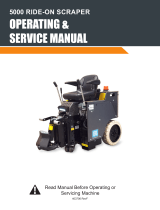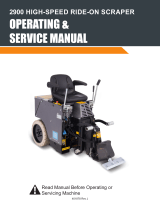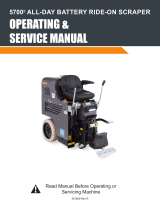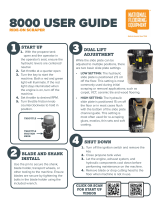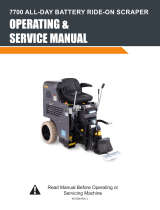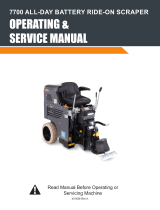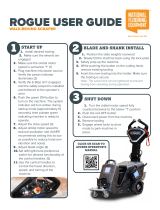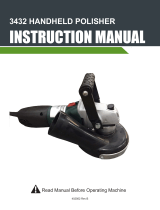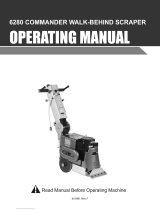Page is loading ...

Read Manual Before Operating or
Servicing Machine
401823 Rev N
5625 PROPANE RIDE-ON SCRAPER
OPERATING &
SERVICE MANUAL


Table of Contents
3
Table of Contents .......................................................................................................................................................... 3
Features and Specications ......................................................................................................................................... 5
Safety ............................................................................................................................................................................. 7
General Rules for Safe Operation ......................................................................................................................... 7
Ride-On Scraper Safety Guidelines ....................................................................................................................... 8
Hydraulic Safety ..................................................................................................................................................... 9
Components and Assembly .......................................................................................................................................11
Transport ...............................................................................................................................................................11
Long-Term Machine Storage ...............................................................................................................................11
Jobsite Movement ................................................................................................................................................ 12
Wheel Size ........................................................................................................................................................... 12
Cutting Head and Blades ..................................................................................................................................... 13
Bracket Conguration .......................................................................................................................................... 15
Operation ...................................................................................................................................................................... 16
Start-Up Procedure .............................................................................................................................................. 16
Controls ............................................................................................................................................................... 16
Shut-Down Procedure ......................................................................................................................................... 17
Changing Propane Tank ...................................................................................................................................... 18
Slide Plate Adjustments and Settings .................................................................................................................. 18
Blade Settings ...................................................................................................................................................... 19
Setup for Specic Application .............................................................................................................................. 19
Ditching ................................................................................................................................................................ 21
Headlight .............................................................................................................................................................. 21
Maintenance Schedule ................................................................................................................................................ 22
Troubleshooting Guide ............................................................................................................................................... 23
Maintenance ................................................................................................................................................................. 24
Manual Slide Plate Removal ................................................................................................................................ 24
Dual Slide Plate Removal .................................................................................................................................... 24
Leak Maintenance ............................................................................................................................................... 25
Hydraulics ............................................................................................................................................................ 25
Change Pump ...................................................................................................................................................... 26
Change Valve ...................................................................................................................................................... 26
Change Wheel Motor ........................................................................................................................................... 26
Check Engine Oil ................................................................................................................................................. 26
Change Engine Oil Filter ...................................................................................................................................... 26
Additional Engine Maintenance ........................................................................................................................... 27
Change Wheel ..................................................................................................................................................... 27
Caster Assembly .................................................................................................................................................. 27
Remove or Replace Foot Peg ............................................................................................................................. 28
Telematics Option ................................................................................................................................................ 28
Parts List and Diagrams ............................................................................................................................................. 29
External Parts ...................................................................................................................................................... 29
Wheels ................................................................................................................................................................. 30
Caster Wheel Assembly ....................................................................................................................................... 30
Foot Pegs ............................................................................................................................................................ 30
Motor Pod Assembly ............................................................................................................................................ 31
Exhaust Assembly ............................................................................................................................................... 32
Top-Mount Fuel Line ............................................................................................................................................ 32
Pump Drive Assembly .......................................................................................................................................... 33
Levers (Dual Lift) ................................................................................................................................................. 34
Levers (Manual Lift) ............................................................................................................................................. 35
Dual Lift ............................................................................................................................................................... 36
Manual Lift ........................................................................................................................................................... 37
Hydraulics ............................................................................................................................................................ 38
Hood Support ....................................................................................................................................................... 39
401823_5625_RevN

Table of Contents
4401823_5625_RevN
Weights ................................................................................................................................................................ 39
Headlight Assembly ............................................................................................................................................. 39
Beacon Assembly ................................................................................................................................................ 40
Light and Tank Bracket Assembly ........................................................................................................................ 40
Labels .................................................................................................................................................................. 41
Wiring Diagrams .......................................................................................................................................................... 42

Features and Specications
5
FEATURES
Non-marking Tires - Large non-marking tires work on all types of
applications and debris build-up.
Adjustable Foot Pegs - Adjustable foot pegs provide optimum com-
fort and ergonomics.
Fork Lift Cups - Easily accessible fork lift cups for loading/unloading.
Debris Deector - Redirects debris away from the operator.
Control Levers - Moves forward, in reverse, turns, and brakes with
easy-to-move levers.
Cutting Head Cylinder Lift - Changes the angle of the cutting head
with the control handle next to the operator seat.
Adjustable Slide Plate - Affords maximum versatility in blade set-
tings.
Quick-Change Swivel Head - Assures continuous blade contact with
the oor.
Headlight - Illuminates work zone.
Fork Lift Cups
Non-Marking Tires
Adjustable Foot Pegs
Headlight
Cutting Head Cylinder Lift
Debris Deector
Quick-Change Swivel Head
Control Levers
Adjustable Slide Plate
401823_5625_RevN

Features and Specications
6401823_5625_RevN
Dual Lift Manual Lift
Machine Variants
Region Serial Number Body Panels Slide Plate
Domestic
(North America)
5625-10XXXX Silver Vein Manual Lift
5625-12XXXX Green Manual Lift
5625-17XXXX Silver Vein Dual Lift
5625-23XXXX Silver Vein Manual Lift
5625DL-23XXXX Silver Vein Dual Lift
International 5625-33XXXX Silver Vein Dual Lift
*Weight includes removable weights, cutting head and transport wheels.
Product Specications
Width Length Height Unweighted
(Machine Only) Weight* Speed RPM Power
26”
(66 cm)
58” (147 cm)
(Manual Lift) 52”
(132 cm)
1,413 lbs (641 kg)
(Manual Lift)
1,915 lbs (869 kg)
(Manual Lift) Up to 200 ft/min.
(61 m/min.) 2,950 25 HP
(18.6 kW)
63” (160 cm)
(Dual Lift)
1,513 lbs (686 kg)
(Dual Lift)
2,015 lbs (914 kg)
(Dual Lift)

Safety
7
Equipment
Use proper parts and accessories.
Only use NFE-approved or recommended parts and accessories.
Using any that are not recommended may be hazardous.
Ensure accessories are properly installed and maintained.
Do not permanently remove a guard or safety device when install-
ing accessories.
Inspect for damaged parts.
Check for misalignment, binding of moving parts, loose fasteners,
improper mounting, broken parts, and any other conditions that
may affect operation. If abnormal noise or vibration occurs, turn
the machine off immediately. Do not use if ignition switch does not
turn machine on and off. For repairs, insist on identical NFE parts.
Maintain equipment and labels.
Keep handles dry, clean, and free from oil and grease. Keep cut-
ting edges sharp and clean. Follow instructions for lubricating and
changing accessories. Motor and switches should be completely
enclosed at all times with no exposed wiring. Inspect cord regu-
larly. Labels carry important information; if unreadable or missing,
contact NFE for a free replacement.
Avoid accidental starting; store idle equipment.
When not in use, ensure that the machine’s propane valve is
closed. Store in a dry, secured place. Remove blades when stor-
ing, and keep away from children.
Wear CO lapel monitor (NFE # 75007) when operating.
The presence of CO will change the impregnated silica color from
red to burgundy, then to gray or black as the concentration levels
increase. Once the detector is exposed to fresh air, it will return
back to red. An unopened pack will last 2-3 years (expiration date
is visible through unopened package on the back). Once opened it
should be replaced approximately every 90 days.
GENERAL RULES FOR SAFE OPERATION
Before use, anyone operating or performing maintenance on this equipment must read and understand this manual, as well as any labels pack-
aged with or attached to the machine and its components. Read the manual carefully to learn equipment applications and limitations, as well
as potential hazards associated with this type of equipment. Keep manual near machine at all times. If your manual is lost or damaged, contact
National Flooring Equipment (NFE) for a replacement.
Personal
Dress properly and use safety gear.
Do not wear loose clothing; it may be caught in moving parts.
Anyone in the work area must wear safety goggles or glasses and
hearing protection. Wear a dust mask for dusty operations. Hard
hats, face shields, safety shoes, etc. should be worn when speci-
ed or necessary. Wear the provided Carbon Monoxide (CO) lapel
monitor when operating.
Maintain control; stay alert.
Keep proper footing and balance, and maintain a rm grip. Ob-
serve surroundings at all times. Do not use when tired, distracted,
or under the inuence of drugs, alcohol, or any medication that
may cause decreased control.
Keep hands away from all moving parts and/or blades.
Wear gloves when changing blades. Remove blade when machine
is not in use and/or lower cutting head to the oor.
Do not force equipment.
Equipment will perform best at the rate for which it was designed.
Excessive force only causes operator fatigue, increased wear, and
reduced control.
Environment
Avoid use in dangerous environments.
Do not use in rain, damp or wet locations, or in the presence of
explosive atmospheres (gaseous fumes, dust, or ammable mate-
rials). Remove materials or debris that may be ignited by sparks.
Keep work area tidy and well-lit - a cluttered or dark work area
may lead to accidents. Extreme heat or cold may affect perfor-
mance. Only use in properly ventilated areas, due to possible CO
exposure.
Protect others in the work area and be aware of surroundings.
Provide barriers or shields as needed to protect others from debris
and machine operation. Children and other bystanders should be
kept at a safe distance from the work area to avoid distracting the
operator and/or coming into contact with the machine. Operator
should be aware of who is around them and their proximity. Sup-
port personnel should never stand next to, in front of, or behind
the machine while the machine is running. Operator should look
behind them before backing up.
Guard against electric shock.
Prevent bodily contact with grounded surfaces, e.g. pipes, radia-
tors, ranges, and refrigerators. When scoring or making cuts,
always check the work area for hidden wires or pipes.
Maintenance & Repairs
Begin maintenance work only when the machine is shut
down, the propane valve is closed, and the engine has cooled.
Use proper cleaning agents.
Ensure that all cleaning rags are ber-free; do not use any aggres-
sive cleaning products.
Ensure machine is properly cleaned and serviced.
Remove all traces of oil, combustible fuel, or cleaning uids from
the machine and its connections and ttings. Retighten all loose
ttings found during maintenance and repair work. Loose or dam-
aged parts should be replaced immediately; use only NFE parts.
Do not weld or ame-cut on the machine during repairs with-
out authorization from NFE.
401823_5625_RevN

WARNING: GRINDING/CUTTING/DRILLING OF MASONRY, CONCRETE, METAL AND OTHER MATERIALS CAN GENERATE DUST,
MISTS AND FUMES CONTAINING CHEMICALS KNOWN TO CAUSE SERIOUS FATAL INJURY OR ILLNESS, SUCH AS RESPIRATORY
DISEASE, CANCER, BIRTH DEFECTS OR OTHER REPRODUCTIVE HARM. IF YOU ARE UNFAMILIAR WITH THE RISKS ASSOCIATED
WITH THE PARTICULAR MATERIAL BEING CUT, REVIEW THE MATERIAL SAFETY DATA SHEET AND/OR CONSULT YOU EMPLOYER,
THE MATERIAL MANUFACTURER/SUPPLIER, GOVERNMENTAL AGENCIES SUCH AS OSHA AND NIOSH AND OTHER
AUTHORITIES ON HAZARDOUS MATERIALS. CALIFORNIA AND SOME OTHER AUTHORITIES, FOR INSTANCE, HAVE
PUBLISHED LISTS OF SUBSTANCES KNOWN TO CAUSE CANCER, REPRODUCTIVE TOXICITY, OR OTHER HARMFUL
EFFECTS. CONTROL DUST, MIST AND FUMES AT THE SOURCE WHERE POSSIBLE. IN THIS REGARD USE GOOD
WORK PRACTICES AND FOLLOW THE RECOMMENDATIONS OF THE MANUFACTURER/SUPPLIER, OSHA/NIOSH, AND
OCCUPATIONAL AND TRADE ASSOCIATIONS. WHEN THE HAZARDS FROM INHALATION OF DUST, MISTS AND FUMES
CANNOT BE ELIMINATED, THE OPERATOR AND ANY BYSTANDERS SHOULD ALWAYS WEAR A RESPIRATOR APPROVED
BY OSHA/MSHA FOR THE MATERIAL BEING CUT.
Safety
RIDE-ON SCRAPER SAFETY GUIDELINES
Before use, anyone operating this equipment must read and understand these safety instructions.
Scraping
Do not drive machine along hills or uneven surfaces.
The weight of the machine may become distributed differently if on
an uneven surface. Too much of an angle could make the machine
unsafe or cause it to tip over. Always keep the front of the machine
facing downward while traveling up or down ramps or inclines. Do
not run the machine in unsafe environments.
Observe location of electrical supplies and extension cords.
Do not allow cutting heads to come into contact with any electrical
supply or extension cord.
Operator must be seated before starting machine and should
stay seated until motor has stopped running.
This machine is equipped with a safety switch under the seat,
which requires the operator to be seated before the machine can
be operated. Do not attempt the start-up procedure without rst
being seated on the machine.
Be aware of protrusions (stud anchors, re-bar, threaded rod, etc.),
cracks, and expansion joints.
Battery
Remove personal metal items when working with batteries.
A battery can produce a short circuit current sufcient enough to
weld metal objects, causing severe burns. Be careful to not drop
metal tools on the battery, as a spark or short circuit could cause
an explosion.
Never smoke or allow a spark or ame near the battery.
Do not block the machine’s air ow.
Blocking ventilation slots or air ow will result in damage to the
machine. Leave space for air to ow freely during operation.
Safety
8
WARNING: BE CAUTIOUS WHEN WORKING WITH
BATTERY. IF ELECTROLYTIC ACID GETS IN THE EYES,
IMMEDIATELY FLUSH OUT WITH COLD, FRESH WATER
FOR AT LEAST 10 MINUTES AND GET MEDICAL HELP.
401823_5625_RevN

Safety
9
HYDRAULIC SAFETY
Maintaining a Safe Work Environment
Establishing a safe work environment in and around your hydraulic equipment is extremely important. The easiest and most effective way to
avoid problems is to make sure associates understand their equipment, know how to operate the machines safely, and recognize the dangers if
handled carelessly. A few things to be aware of are:
• Pressure: Hydraulic uid under pressure is dangerous and can cause serious injury. Never look for a leak when unit is under pressure.
Using your hand could cause serious injury. A few common ways to encounter hydraulic uid under pressure include:
▪ Pinhole: Fluid under pressure can cause serious injury. It can be almost invisible escaping from a pinhole, and it can pierce the skin
into the body.
▪ Leak: Keep ttings and hoses tight. Only check and service when not under pressure. Leaking hydraulic uid is hazardous; in addition
to making workplace oors slippery and dangerous, it also contaminates the environment. Before cleaning an oil spill, always check
EPA, state, and local regulations.
▪ Burst: Whether due to improper selection or damage, a ruptured hose can cause injury. If it bursts, a worker can be burned, cut,
injected, or may slip and fall.
▪ Coupling Blow-Off: If the assembly is not properly made or installed, the coupling could come off and hit or spray a worker, possibly
resulting in serious injury. Never operate machine without guards.
• Flammability: When ignited, some hydraulic uids can cause res and/or explode.With the exception of those comprised primarily of
water, all hydraulic uid is ammable (including many “re-resistant” hydraulic uids) when exposed to the proper conditions. Leaking pres-
surized hydraulic uids may develop a mist or ne spray that can ash or explode upon contact with a source of ignition. These explosions
can be very severe and could result in serious injury or death. Precautions should be taken to eliminate all ignition sources from contact
with escaping uids, sprays or mists resulting from hydraulic failures. Sources of ignition could be electrical discharges (sparks), open
ames, extremely high temperatures, sparks caused by metal -to -metal contact, etc.
• Mechanical: Hydraulic uid creates movement, which means some equipment may move. Observe surroundings and equipment at all
times.
• Moisture: Do not use in wet or high moisture conditions.
• Electrical: Faulty wiring can be an electrical hazard. A regular preventive maintenance program should always include a wiring check. If
applicable, disconnect battery before serving.
• Temperature: Because this machine operates at a relatively low pressure, overheating is not common. If surface of tank becomes too hot
to touch by hand (above 130ºF or 55°C), shut off machine and allow it to cool.
Hydraulic Fluid
Only use Texaco Rando 46 Hydraulic Oil or compatible uid like ISO or AW #46 from a brand name manufacturer. Non-compatible uids could
cause damage to unit or serious injury.
CAUTION: NEVER USE YOUR HANDS TO CHECK FOR LEAKS OVER HOSE OR HYDRAULIC CONNECTIONS. USE A PIECE OF CARD-
BOARD TO LOCATE A PRESSURIZED LEAK. FOR LOW PRESSURE LEAKS (DRIPS), USE A RAG TO CLEAN THE AREA AND DETERMINE
WHERE THE LEAK ORIGINATES.
DANGER: DO NOT TOUCH A PRESSURIZED HYDRAULIC HOSE ASSEMBLY WITH ANY PART OF THE BODY. IF FLUID PUNCTURES
THE SKIN, EVEN IF NO PAIN IS FELT, A SERIOUS EMERGENCY EXISTS. OBTAIN MEDICAL ASSISTANCE IMMEDIATELY. FAILURE TO DO
SO COULD RESULT IN LOSS OF THE INJURED BODY PART OR DEATH.
9401823_5625_RevN

THIS PAGE INTENTIONALLY LEFT BLANK

Components and Assembly
TRANSPORT
• Secure machine down with ratchet straps when transporting the machine. Straps
need to be rated at least twice the weight of the machine.
• Never leave machine unattended on an incline; chock wheels to keep machine
from rolling.
• Hydraulic levers should be straight up in the “neutral” position, not locked in the
forward or backward position.
• Lift machine off swivel caster or transport wheels by lowering cutting head for better
stabilization.
• Always remove blade and cutting head when machine is being moved or trans-
ported. Slide plate can be removed to make the machine more compact.
• Removing any added weight prior to loading/unloading makes this process easier
and safer.
Dock Heights
It is best to load or unload the machine from a level dock height, e.g. a van from a van
dock height or a truck/semi from a regular dock height.
Power Gate
A power gate can be used when the appropriate dock height is unavailable. Ensure gate
is properly rated for machine. To better secure machine, raise machine off the caster and
onto the lowered cutting head. Tie machine down; chock wheels.
Fork Lift Cups
There are two fork lift cups mounted under the front of the machine (Figure 1). Slide fork
lift forks through fork lift cups. Slide forks all the way back to where they almost touch the
rear tire (Figure 1.1). Before lifting machine, secure machine to fork lift with heavy 3000
lb. or heavier rope or chain. Tilt forks back to lift machine (Figure 1.2).
Wheel Chocks
Wheel chocks will help to secure the machine, but do not use wheel chocks on their own.
LONG-TERM MACHINE STORAGE
1. Follow the procedure for shutting down the machine in the Operation section.
2. After engine has completely cooled down, disconnect propane line.
3. Remove negative terminal on battery.
FIG. 1
FIG. 1.1
11
FIG. 1.2
CAUTION: MACHINE IS BACK HEAVY. DO NOT RUN ON STEEP INCLINE
THIS COULD CAUSE MACHINE TO TIP OVER! (FIGURE 1). DO NOT USE A
RAMP TO MOVE MACHINE.
WARNING: MACHINE HAS A SWIVEL FRONT CASTER. NEVER SIDE HILL
(FIGURE 2) THE MACHINE ON A INCLINE WITHOUT POWER, THE FRONT
CASTER WILL CAUSE MACHINE TO SWING TO THE LOWEST POINT. IF IT IS
NECESSARY TO RUN MACHINE ON AN INCLINE, RUN MACHINE ON CUTTING
HEAD. PLACE AT LEAST AN 8’’ CUTTING HEAD IN MACHINE. TO KEEP FROM
DAMAGING FLOOR, CLAMP A PIECE OF CARPET INTO CUTTING HEAD. THIS
WILL GIVE POSITIVE CONTACT WITH THE FLOOR WHEN POWER IS DISEN-
GAGED FROM THE WHEELS.
401823_5625_RevN

Components and Assembly
12
JOBSITE MOVEMENT
Taping Wheels
Taping the wheels with a wide masking tape can prevent damage to oors during move-
in and move-out.
Front Wheel Assembly
The front wheel assembly (Figure 2) is included and very helpful when moving the
machine around on a job site or loading the machine that is not on a pallet. It allows ma-
chine stability and safe transportation over most surfaces. It is easy and quick to attach
or detach.
1. Raise slide plate so the bottom of the slide plate is higher or even with the bottom
of the guide channels.
2. Raise cylinder; remove cutting head or shank.
3. Insert the front wheel assembly into the cutting head.
4. Secure with securing pin.
Moving Machine without Power (Pushing Machine)
Forward: To move the machine forward, levers need to be pushed forward. To lock
levers in place, connect a bungee-strap from each lever (pushing levers forward), pulling
straps down to and connecting to the front plate (Figure 3). Never leave machine unat-
tended with strap holding levers open.
Backward: To move machine backward, levers need to be pulled backwards. To lock
levers in place, connect a bungeestrap from each lever (pushing levers backward), Pull-
ing straps to the back of the machine and connecting behind the seat or the rear of the
machine (Figure 3.1). Never leave machine unattended with strap holding levers open.
Moving Machine on Caster
Moving a weighted machine only on the front caster and not on the cutting head or the
front wheel assembly can seem to make the machine turn sluggish. It might turn hard to
the right or the left, which is normal.
WHEEL SIZE
An 18’’ wheel comes standard on the machine. This wheel will work on all types of ap-
plications and ooring with heavy debris build-up (VCT, ceramic etc.). It also works well
for slippery/slimy residue, ie. double stick.
Keep wheels clean and free of debris, make sure it can move freely. Clean as needed;
inspect before each use.
WARNING: PROTECT OTHERS IN WORK AREA. PROVIDE BARRIERS OR
SHIELDS AS NEEDED TO PROTECT OTHERS FROM DEBRIS AND MACHINE
OPERATION. OPERATOR SHOULD BE AWARE OF WHO IS AROUND THEM AND
THEIR PROXIMITY.
WARNING: ALWAYS REMOVE STRAPS BEFORE STARTING MOTORS.
FAILURE TO DO SO WILL MAKE MACHINE MOVE AND MAY CAUSE PROPERTY
DAMAGE AND/OR BODILY INJURY.
FIG. 3 FIG. 3.1
401823_5625_RevN
FIG. 2

Components and Assembly
CUTTING HEAD AND BLADES
Matching the correct cutting head, blade size, blade angle and added weight to the ma-
chine to make the material removal as easy as possible is important. For every material
being removed, there is an optimum blade width, thickness, sharpness, angle and bevel
(bevel up or bevel down).
The machine is supplied with a 12” cutting head. Having additional cutting heads will
save time on the job. Insert blades into the extra cutting heads before starting a job.
When the blade is dull, instead of taking the time to replace it or sharpen it on the job,
take out the cutting head and replace it with another.
Shear Point
The shear point is the point where material to be removed will cut cleanly from the oor. If
the blade is too wide, too dull or too steep, the shear point is lost.
Inserting Cutting Head
1. With machine off, insert desired cutting head into cutting head holder.
2. Secure with cutting head clip.
Swivel Head
The swivel head keeps the blade in contact with the oor even when the oor is uneven.
When using a at blade, by swiveling the head over 180° allows another sharp edge on
the blade without having to replace the blade.
Inserting or Changing Blades
Sharp blades are imperative for good performance. Always wear gloves when handling
blades.
1. Using a 3/4’’ socket wrench, loosen bolts on cutting head. Quantity of bolts will very
depending upon cutting head size.
2. Insert blade into the cutting head to back of notch (Figure 4); tighten rmly.
Note: A cordless 3/8’’ drive impact wrench will speed up this process.
Inserting a Shank Blade
Shank blades do not require a cutting head.
1. Insert desired shank blade into cutting head holder.
2. Secure with cutting head clip.
Self-Scoring Blades
Instead of pre-scoring a job, for soft goods (carpet, vinyl, linoleum, membrane) the
self-scoring blades automatically do the scoring. It is important to keep the “wings” on a
self-scoring blade sharp.
13
FIG. 4
Blade Securing Bolt Cutting Head
Blade Notch
401823_5625_RevN
WARNING: BLADES ARE SHARP, USE EXTREME CAUTION. NEVER
CHANGE CUTTING HEAD OR SERVICE BLADES WHILE MACHINE IS RUN-
NING.
WARNING: DISARM MACHINE WHEN MACHINE IS NOT IN USE. REMOVE
THE CUTTING HEAD OR LOWER CUTTING HEAD TO THE FLOOR. FAILURE
TO DO SO COULD CAUSE SEVERE BODILY INJURY.

Components and Assembly
14 401823_5625_RevN
THIS PAGE INTENTIONALLY LEFT BLANK

Components and Assembly
BRACKET CONFIGURATION
Your machine will arrive from National Flooring Equip-
ment (NFE) with the bracket bolted to the oor of the
crate; it will require conguration on the machine prior
to use.
If your propane tank has a length of approximately
21 inches (NFE tank size)...
Unbolt the bracket from the crate; use the bolts already
connected to the hood to congure the bracket on the
machine as follows (Figure 7):
1. L shapes on the bracket should be facing outward
(Figure 7A).
2. Right side of the bracket should be bolted to the
outermost set of holes on the right.
3. Left side of bracket should be bolted to the holes
second-furthest from the left.
If your propane tank has a length of approximately
28 inches (fork lift tank size)...
Unbolt the bracket from the crate; use the bolts already
connected to the hood to congure the bracket on the
machine as follows (Figure 8):
1. L shapes on the bracket should be facing inward
(Figure 8A).
2. Right side of the bracket should be bolted to the
outermost set of holes on the right.
3. Left side of bracket should be bolted to the outer-
most set of holes on the left.
Note: Holes may be hidden by label. Find the holes by
running your hand over the label; cut the label so that
they are usable.
For assistance, contact NFE Customer Service.
15 401823_5625_RevN
Figure 7
Figure 7A
Figure 8
Figure 8A

Operation
START-UP PROCEDURE
1. Insert key to the power key start (Figure 9).
Note: The machine is equipped with a kill switch in the seat, so it will not start unless the
operator is properly seated.
2. Open propane tank valve by turning knob counterclockwise until fully open.
3. Ensure that hydraulic levers are centered.
4. Set throttle at a quarter open.
5. Start machine with ignition switch. Both a red and green light will illuminate (Figure
6). Do not hold in the “on” position for more than ve seconds.
6. As soon as the engine starts, the red light will shut off. If the Red light does not shut
off, turn machine off.
7. Adjust throttle to desired RPM.
Note: If machine is not running but the key is in the ignition and in the “on” position, the
hour meter will continue to run.
CONTROLS
Throttle Control
1. With machine on, adjust throttle to desired RPM by pulling up on the throttle control.
2. When at desired RPM, turn throttle friction knob counter-clockwise to hold in posi-
tion (Figure 10).
Hydraulic Levers
The hydraulic levers (Figure 11) steer the machine. They are feathered spool valves. For
smooth even movement, always move levers slowly. Fast movement on control levers
will result in jerky, uneven movement.
• To move the machine forward, push both levers forward ↑↑ .
• To move the machine backward, pull both levers backward ↓↓ .
• To turn the machine quickly to the right, move the left lever forward and the right
lever backward ↑↓ .
• To turn the machine quickly to the left, move the left lever backward and the right
lever forward ↓↑ .
• To turn the machine slowly to the left or right, push the left or right lever forward ↑
or backwards ↓ .
• Correcting direction while moving forward is accomplished by slightly reducing
pressure on one lever or the other while moving.
• Placing levers in the center position will cause the wheels to lock-up.
16
FIG. 11
Hydraulic Levers
FIG. 10
Throttle
Throttle
Friction
Knob
FIG. 9
Green Light
Red Light
Hour Meter
Throttle
Key Start
401823_5625_RevN

Operation
17
Cylinder Lift Lever
The cylinder lift lever (Figure 12) raises and lowers the cylinder and cutting head. After
setting slide plate to proper height, use the cylinder lift lever to set blade to proper cutting
angle.
• Pull back ↓ on the cylinder lift lever to raise the cutting head.
• Push the cylinder lift lever forward ↑ to lower the cutting head.
• Continuing to push the cylinder lift lever forward and it will adjust the angle of the
cutting head. This will also lift up the front of the machine. Note: This will need to
be done when doing maintenance on the machine (ie: wheel changing, front caster
maintenance etc). When doing machine maintenance, besides raising the cutting
head angle, place blocks under the machine. Never use the cutting head only.
SHUT-DOWN PROCEDURE
1. Move the machine to level ground.
2. Turn off the ignition switch and remove the key.
3. Do not move hydraulic levers. The hydraulic system is the brake system. Moving
levers could cause machine to roll, causing damage to machine, property damage
and/ or bodily injury.
4. Wait until motor has stopped completely.
5. Close propane tank valve (Figure 13).
6. Let the engine, exhaust system and hydraulic components cool down before per-
forming maintenance on the machine.
FIG. 12
WARNING: DO NOT ALTER A SWITCH OR LEVER. DO NOT DEFEAT A
SAFETY DEVICE.
WARNING: DISARM MACHINE BY REMOVING THE CUTTING HEAD OR
LOWERING THE CUTTING HEAD TO THE FLOOR WHEN THE MACHINE IS NOT
IN USE.
WARNING: ENGINE, EXHAUST SYSTEM, AND HYDRAULIC COMPONENT
TEMPERATURES COULD BE IN EXCESS OF 200° F, CAUSING SEVERE BURNS
IF TOUCHED.
Cylinder Lift
Lever
WARNING: BE AWARE OF THE MACHINE’S OPERATING ANGLES AND
CAUTIOUS OF ANY UNBALANCED MACHINERY OR TOOLING. WHEN CHANG-
ING FROM A LOW SLIDE PLATE TO A HIGH SLIDE PLATE SETTING, A LOW
CUTTING HEAD TO A HIGH CUTTING HEAD ANGLE, OR WHILE OPERATING
ON A SURFACE THAT IS NOT LEVEL, THE WEIGHT OF THE MACHINE MAY BE
DISTRIBUTED DIFFERENTLY OR MAY BECOME UNBALANCED. TOO MUCH OF AN ANGLE
COULD MAKE THE MACHINE UNSAFE OR CAUSE A TIP-OVER. DO NOT RUN THE MACHINE
IN UNSAFE ENVIRONMENTS.
401823_5625_RevN
FIG. 13
Propane
Tank Valve

Operation
CHANGING PROPANE TANK
1. Follow shut-down procedure to turn off machine.
2. Release tank bracket so that it swings back. Bracket does not need to be removed
completely.
3. Disconnect propane hose (Figure 14).
4. Remove tank.
5. Reverse steps for replacement.
SLIDE PLATE ADJUSTMENT AND SETTINGS
Manual Lift (Figure 15)
• Loosen the four bolts on the front of the slide plate with a 1-1/8’’ wrench. Slide plate
up or down to achieve the desired height of the cutting head. Firmly tighten all four
bolts when nished.
• A low setting orients the slide plate approximately 1” (2.5 cm) off the oor. This is
for normal removal of most materials.
• A high setting orients the slide plate approximately 6” (15 cm) off the oor. This is
for re-scraping glue and some thin-soft coatings.
Dual Lift (Figure 16)
• Prior to adjusting the dual lift hydraulic slide plate, ensure the channel guide is free
of any debris and the machine is safely positioned on a at surface.
• To set the height of the hydraulic slide plate start, adjust the angle of the cutting
head holder with the cylinder lift lever. Pull back on the cutting head lever and raise
the cutting head holder to an angle higher than the bottom of the slide plate.
• The lever adjacent to the right hand control lever raises and lowers the hydraulic
slide plate. To lower the slide plate, push forward on this lever. To raise the slide
plate, pull back on the lever.
Settings
While the hydraulic slide plate can be adjusted to multiple positions, there are two basic
slide plate settings:
• Low Setting: the hydraulic slide plate is positioned 1” off the oor. This setting is
most commonly used during initial scraping or removal applications; such as car-
pet, VCT, ceramic tile and wood ooring. Note: The “low” setting on older model hy-
draulic slide plates may stop the plate within one to two inches of the oors surface.
• High Setting: the hydraulic slide plate is positioned 6” off the oor or in most cases
ush with the bottom of the slide plate channel guide. This setting is most often
used for re-scraping glues, mastics, thin sets and soft coating.
18
FIG. 16
FIG. 15
401823_5625_RevN
WARNING: WHEN ADJUSTING THE SLIDE PLATE, KEEP FEET AND
HANDS OUT FROM UNDERNEATH THE CUTTING HEAD AND SLIDE
PLATE. FAILURE TO DO SO COULD CAUSE SEVERE BODILY INJURY.
WHEN BOLTS ARE REMOVED FROM THE SLIDE PLATE, THE CUTTING
HEAD AND SLIDE PLATE WILL DROP TO THE FLOOR.
FIG. 14

Operation
Steep Cutting Head Angle
A steep angle is only used for re-scraping. The slide plate has to be raised so the bottom
of the slide plate is higher or even with the bottom of the guide channels. Not raising the
slide plate when operating the machine at a steep angle will cause the machine to jump
and buck. It does not give the operator a clear vision of the cutting head and it raises the
machine to operate at a unsafe operating height (Figure 17). Failure to raise the slide
plate could cause machine damage and/or bodily injury.
BLADE SETTINGS
• Dull blades greatly reduce cutting ability; sharpen or replace as needed.
• Start with a narrow blade, then increase blade size to optimize cutting pass. Nar-
rower blades work easier than wider blades and usually clean the oor better.
• For harder jobs, use a smaller blade.
• Normally, bevel on blade is up for concrete; bevel down on wood and shoe blades
for soft sub-oors.
• Keep your work area clean and clear of debris.
• After you have removed a portion of material, move it out of the way. This will give
the machine maximum performance and help to keep the work area safe.
Weight vs. Sharpness
The most common way to compensate for a dull blade is to add more weight and raise
the blade angle. Weight allows dull blades to be used to a point. Weight also causes
blades to dull and break easier. Blades of any thickness tend to catch cracks and expan-
sion joints and will bend or break the blade if set at a high angle. For best results, run a
small ditching blade at a low angle to identify as many cracks and joints as possible. If
blades are breaking, the conditions of use have been misunderstood.
SETUP FOR SPECIFIC APPLICATION
Ceramic
The slide plate should be adjusted to a low setting 1” off the oor. Use a shank blade or
a shank blade with a carbide tip.
Wood
The slide plate should be adjusted to a low setting 1” off the oor. Use shank blades,
shank blades with carbide tips or a 6”or 8” cutting head with shoe blades, bent shoe
blades, or heavy duty blades.
Note: Run machine 45° to the grain of the wood.
A heavy machine cannot be used on wood suboors or raised panel computer oors.
Keep machine light, remove all weights. A weighted machine could break through the
oor. The slide plate should be adjusted to a low setting 1” off the oor. Blades should be
as at of an angle as possible. Use a shoe blade, extra heavy duty blade (these blades
have a bend to them) or a regular blade, bevel up. When using a regular blade, bending
up the corners of the blade will help from the blade digging into the oor. Sometimes a
shank blade or a shank blade with a carbide tip will work. Allow blade to shear material
19
FIG. 17
Slide Plate Is Not Raised
401823_5625_RevN

Operation
20
from the oor. The trick on wood oors is to run the blade at. Approach should be at a 45° angle to the board. This keeps from digging into the
board and hanging up at the seams.
Secondary-Backing Carpet
The slide plate should be adjusted to a low setting 1” off the oor. Use a cutting head from 10”-27” with heavy duty blades or a cutting head from
10”-14” with a self-scoring blade.
Foam-Back Carpet
The slide plate should be adjusted to a low setting 1” off the oor. Use cutting heads from 10”-14” with self-scoring blades. If it is not stuck tight,
use a cutting head from 14”-27” with a standard blade.
Double-Stick Carpet
The slide plate should be adjusted to a low setting 1” off the oor. It is best to test to see which is the easiest way to remove double stick. Start
with a cutting head from 10”-14” with self-scoring blades. Use self-scoring blades with 4” wings, 6” or 12” wide for best results. In some cases,
carpet might pull off the pad and then scrape up the pad separately. Usually leaving carpet connected to the pad works the best. Sharp blades
are necessary for proper operation.
Note: When removing carpet from over VCT Tile and the tile needs to be saved, run the machine at a 45° angle over the tile. This should help
to save the tile.
VCT Tile
The slide plate should be adjusted to a low setting 1” off the oor. If goods come up easily, change to a larger cutting head. If goods come up
harder, use a cutting head from 6”-8” with a premium high tempered blade (.062) to match cutting head size. Sometimes a .094 blade may work
better. If goods remove easily, a Tile Box #7074 can be used. A tile box also works for wind rowing, assists for a fast clean-up and collection of
tile debris for quick removal.
Rubber Tile
The slide plate should be adjusted to a low setting 1” off the oor. Use a cutting head from 6”-14” with self-scoring blades or use ditching
method with a at blade.
Re-Scraping
Slide plate should be set high, 6’’-8’’ off the oor. Use a cutting head from 8”-27” with scraper blades to match cutting head size. A 15” scrap-
per blade would use a 14” cutting head. Razor blades are faster but a cutting head from 8”-14” can be used with a standard blade. Flip head
regularly.
Thin Coating
Slide plate could be set high, 6’’-8’’ or low 1” off the oor. Test to see which works best. Use a cutting head from 8”-27” with razor blades to
match cutting head size.
Concrete
Blade should be bevel up when working over concrete. Pretty much anything over concrete works. Try different set-ups to see which works
best. If goods come up difcult, the slide plate should be at a low setting, 1” off the oor. Use a smaller size blade. If goods come up easily, a
wider blade can be used.
Soft Sub-Floor
The slide plate should be adjusted to a low setting 1” off the oor. Blades should be as at of an angle as possible. Use a shoe blade, extra
heavy duty blade (these blades have a bend to them) or a regular blade, bevel down. When using a regular blade, bending up the corners of the
blade will help from the blade digging into the oor. Sometimes a shank blade or a shank blade with a carbide tip will work.
401823_5625_RevN
/
